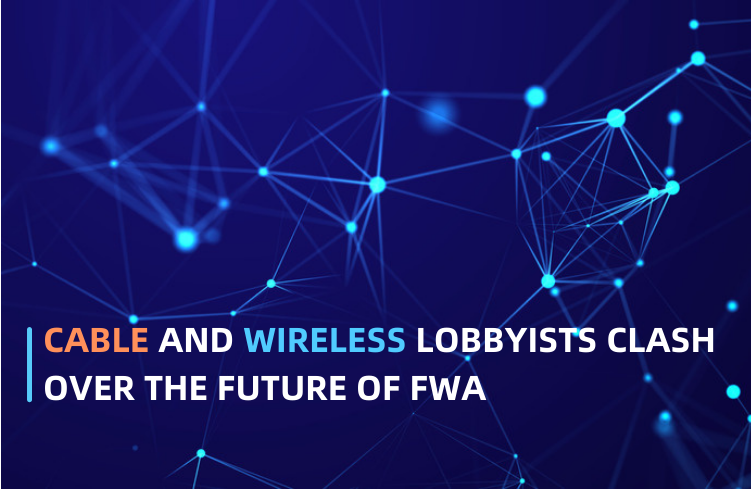
Lobbyists backed by the cable industry are working to prevent 5G providers from obtaining more spectrum in the lower 3GHz band. Cable's goal is to prevent the expansion of fixed wireless access (FWA) services across the US, according to lobbyists from the wireless industry.
"Instead of innovating to meet the new competitive challenge they face, cable is trying to block policies that stimulate investment and competition," wrote Nick Ludlum, a top official with the CTIA, which is the main trade association for wireless network operators like AT&T, Verizon and T-Mobile.
Ludlum argued that FWA services are cutting into cable's core Internet business, and as a result the cable industry is working to "cut off access to the raw material that would supercharge competition – dedicated licensed spectrum."
But that's not how the cable industry sees things. According to Spectrum for the Future – a lobbying group backed in part by the nation's biggest cable companies – the real problem lies with FWA providers like Verizon and T-Mobile. Those companies want to "pursue old school approaches to spectrum licensing that will only reinforce the dominance of Chinese equipment from companies like Huawei."
Threats from China play heavily in a variety of policy disputes in the telecom industry.
Instead, Spectrum for the Future is pushing for spectrum sharing regimes rather than the dedicated, licensed spectrum scenarios favored by the wireless industry. The group wrote that spectrum sharing can "ensure widespread market competition without sacrificing vital US military applications."
Indeed, the cable industry has only participated in one major FCC spectrum auction, of the CBRS 3.5GHz band. That band sports a unique spectrum sharing scenario.
Spectrum for the Future, formed last year, counts backers including Comcast, Cox and Charter, as well as other companies and entities like Celona, Federated Wireless and Public Knowlege. David Redl, a former official with the NTIA, is an advisor to the association.
The lobbying debate between CTIA (the wireless association) and Spectrum for the Future (backed by cable companies) reflects the real-world fight between 5G providers like Verizon and cable giants like Charter Communications. And it could well sit at the heart of the years-long political squabble over the lower 3GHz band.
A band for the military
The US Department of Defense (DoD) currently uses the lower 3GHz spectrum band to operate its radars, satellites, navigation equipment and more. But the 5G industry has been trying for years to convince the White House to reallocate some or all of that band for cellular operations.
The fight over the future of the band has spread across Washington, DC. For example, the FCC's auction authority was not renewed last year in part because of the lower 3GHz fight.
In order to move the issue forward, the NTIA conducted a two-year study into the band. However, the findings of its Emerging Mid-Band Radar Spectrum Sharing (EMBRSS) feasibility assessment haven't been released. And the Biden administration's national spectrum strategy recently called for another study of "dynamic spectrum sharing" in the band.
"At this time, it would be counterproductive to initiate additional studies of the lower 3GHz band," wrote a trio of lawmakers earlier this year in a letter to the White House.
"We remain concerned that pursuing a policy of requiring the Department of Defense … to surrender its spectrum for non-federal use would significantly harm DoD's ability to carry out its missions, increase costs, and adversely affect our national security," wrote Sens. Deb Ficher (R-Neb.), Mazie Hirono (D-Hawaii), and Angus King (I-Maine). The three lawmakers are members of the Senate Armed Services Committee.
However, a top official in the DoD said recently that the agency would consider moving some of its airborne radar operations off the lower 3GHz band in order to free it up for 5G operations. DoD CIO John Sherman said the agency would prefer to share the spectrum, but he hinted that the DoD might also be open to "some limited, paid-for relocation."
The debate over the lower 3GHz band comes as the 5G industry looks for more spectrum, including for FWA. A recent study commissioned by CTIA found that 5G networks may begin to run out of capacity within the next five years.
After all, wireless networks are limited primarily by spectrum – with more spectrum, operators can offer faster speeds and support more customers.
The rise of fixed wireless
FWA has grown into a major trend in the US telecommunications industry. "5G FWA has been capturing broadband share rapidly, accounting for 90% of net additional broadband Internet subscribers in 2022, and is expected to continue at 80% to 90% through 2024," wrote Deloitte in its new 2024 telecommunications industry outlook.
"Initially, it seemed likely that most customers switching to FWA would be former DSL subscribers, specifically those who were miles away from telecom central offices and whose DSL speeds were slow," Deloitte continued. "However, in recent quarters it seems that the growth in FWA subs is also coming at the expense of cable subscribers, with the number of cable broadband net [customer] adds falling or even going negative."
Others agreed.
"Cable's greenfield builds are not enough to offset the competitive pressures from FWA and FTTH [fiber-to-the-home]. Lack of visibility is driving cable sentiment to all-time lows," wrote the financial analysts at TD Cowen in a recent note to investors.
Partly as a result, shares in cable giant Charter Communications have fallen 30% during the past six months. Comcast's shares are down 8% over the same period.
Meanwhile, investor sentiment in fixed wireless providers is improving. T-Mobile's stock has gained 20% over the past six months, while AT&T's shares are up around 18%. Verizon's shares are up more than 22%.
And customers are cheering the competition.
Getting satisfaction
According to new numbers from Parks Associates, 66% of 5G FWA subscribers consider their plans to be set at a fair or good price, while 62% report that it is easy to contact someone for customer service or technical support. Among fiber subscribers, 51% feel they receive their service at a fair price. Among cable customers, that figure is just 35%. The firm based its study on a survey of 8,000 Internet households.
"Incumbent ISPs in previously uncompetitive markets are most at-risk from growing awareness of MNO [mobile network operator] FWA plans," Parks Associates' Kristen Hanich said in a release.
Another FWA driver is the simplicity of the offering. "The main advantage that FWA provides over other connectivity technologies is convenience," according to an Ericsson FWA survey of 23,000 respondents across 19 countries. "A common sentiment echoed by households that have or plan to acquire FWA was the appeal of the convenience of FWA as a solution."
In the US, both Verizon and T-Mobile allow their FWA customers to install the service themselves, typically by sending them a receiver through the mail. To start their service, all customers have to do is plug in the receiver. If the setup doesn't work, they can then return the receiver. "No harm, no foul," according to one analyst.
The FWA threat is clearly on the minds of cable executives. Charter, for example, used its pricey Super Bowl ad to criticize T-Mobile's FWA service. And T-Mobile used its own Super Bowl spot to tout the ease of its FWA installation compared with waiting for "the cable Internet guy."
FWA puts and takes
To be clear, there are changes afoot in the pace of FWA adoption in the US.
First, T-Mobile has signaled that its FWA growth rate will slow in the coming months. It expects net customer additions to slow to 400,000 quarterly, down from 500,000 during the past year or two.
That's noteworthy considering wireless industry officials have long warned that 5G networks will eventually become overloaded with FWA traffic. OpenVault recently forecast that average monthly home Internet usage will hit 1 terabyte by 2029, up from 700 gigabytes this year.
That's partly why some in the cable industry have described FWA as a "parking lot" for future cable subscribers.
But there are a few wildcards still to be played. The first: AT&T.
AT&T is a late entrant into the FWA market. But by the fourth quarter of last year, the operator counted around 100,000 5G FWA customers.
The financial analysts at New Street Research recently forecast that AT&T's FWA efforts will peak at about 180,000 net customer additions per quarter by late 2025. That peak is expected to run for between six and eight quarters, if AT&T follows the same path as T-Mobile and Verizon, the research firm added.
Thus, if AT&T decides to go big with FWA, that could pick up any slack left by a T-Mobile or Verizon slowdown.
Further, officials from both T-Mobile and Verizon have hinted that they may pursue the FWA market beyond their current 2025 targets (7-8 million customers for T-Mobile and 4-5 million for Verizon).
"We are absolutely building ahead of the [network] capacity needs," Verizon's Joe Russo said recently. He suggested Verizon could gain more FWA customers beyond its 2025 goal by using its millimeter wave (mmWave) spectrum and potentially targeting apartment buildings in addition to homes.
"There is some optionality there," he said.
T-Mobile officials have offered a similar outlook. But company officials have said T-Mobile won't grow its FWA business beyond its current 2025 goal (7-8 million customers) without some kind of investment into additional infrastructure.
Undoubtedly, the release of additional spectrum in the lower 3GHz band would supercharge FWA offerings in the US. It would likely allow operators like Verizon, T-Mobile and AT&T to significantly expand the reach and capacity of their fixed wireless offerings. However, it's unlikely that regulators will move quickly to release the lower 3GHz band. After all, military operations would first need to be relocated.
It's also unclear whether 5G providers would be interested in spectrum released under a sharing regime. Verizon was the only major 5G operator to participate in the FCC's CBRS auction of shared spectrum.
Source: https://www.lightreading.com/regulatory-politics/cable-and-wireless-lobbyists-clash-over-the-future-of-fwa?action=profile_completion&

